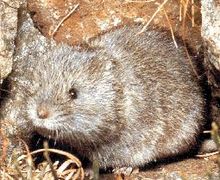Microtus nivalis
| European snow vole | |
|---|---|
 |
|
| Scientific classification | |
| Kingdom: | Animalia |
| Phylum: | Chordata |
| Class: | Mammalia |
| Order: | Rodentia |
| Family: | Cricetidae |
| Genus: | Chionomys |
| Species: | C. nivalis |
| Binomial name | |
|
Chionomys nivalis (Martins, 1842) |
|
| Synonyms | |
|
Arvicola nivalis Martins 1842 |
|
Arvicola nivalis Martins 1842
The European snow vole or snow vole (Chionomys nivalis, previously Arvicola nivalis and Microtus nivalis) is a species of rodent in the family Cricetidae. It has dense, pale grey fur and a pale-coloured tail and can reach about 14 cm (5.5 in) long, with a tail which is 7 cm long.
The European snow vole is native to mountainous parts of southern and eastern Europe and southwestern Asia. It is found in the Pyrenees, the Alps, the Apennine Mountains, the Carpathian Mountains, the Montesinho mountains, the higher regions of the Balkans and Asia Minor. Its habitat is rocky areas and screes, mostly above the tree line. It is mainly a solitary animal and lives under boulders and in crevices and tunnels among rocks and scree.
The European snow vole was first described by Martins in 1842 as Arvicola nivalis. Gromov and Polyakov erected the genus Chionomys in 1972 and the name Chionomys nivalis is now accepted, although the exact affinities of the species are not fully established. Fossil evidence suggests that Chionomys nivalis had evolved in Europe by the late and that the other two members of the genus, Robert's snow vole (Chionomys roberti) and the Caucasian snow vole (Chionomys gud) evolved in the Caucasus and Near East regions with Robert's snow vole splitting off from the ancestral line by the middle Pleistocene. All members of the genus have a distribution in the south-western palearctic and are restricted to a broad band of territory about 5,500 kilometres (3,400 mi) long and 2,500 kilometres (1,600 mi) wide. All three species are present in the Caucasus and the Pontic Mountains in northeastern Turkey.
...
Wikipedia

